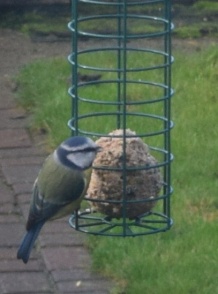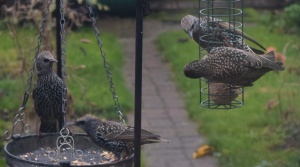 I like the idea of being able to do a bit of ‘citizen science’, collecting data for a worthwhile cause, while doing something I enjoy. My first experience of this was doing the RSPB’s Big Garden Bird Watch every January for the last few years. A couple of years ago I started doing Butterfly Conservation’s annual survey, and I’ve also done Plantlife’s Wildflowers Count (now the National Plant Monitoring Scheme) which involves visiting a fixed route or plot and recording all of the wildflower plants you see.
I like the idea of being able to do a bit of ‘citizen science’, collecting data for a worthwhile cause, while doing something I enjoy. My first experience of this was doing the RSPB’s Big Garden Bird Watch every January for the last few years. A couple of years ago I started doing Butterfly Conservation’s annual survey, and I’ve also done Plantlife’s Wildflowers Count (now the National Plant Monitoring Scheme) which involves visiting a fixed route or plot and recording all of the wildflower plants you see.
As well as feeling like I’m doing something useful, I like the structure of having a survey to complete, a list of things to look out for, some help with ID, and using it as a starting point for finding out more about different species and habitats. I’ve learned a lot about wildlife from taking part in these surveys.
When I did the RSPB survey this January I found myself thinking (as I do every year) that I would enjoy doing this more regularly. After a bit of Googling, I came across the BTO’s Garden BirdWatch (GBW), which involves weekly recording of the birds which visit your garden. There is no specific time commitment, they just ask that you try to be consistent from week to week with the amount of time you spend and the times of day you watch. For me the easiest way to do this is to watch the birds early most mornings out of the kitchen window while I make breakfasts and packed lunches. I also do half an hour one afternoon. There is also the option to record insects, mammals and amphibians visiting the garden.
When you register you give details of the type of garden you have, including location, size, any trees, food plants  and ponds, and each week, along with species seen, you record the type of food (if any) you have put out. Apart from having a garden there are no specific requirements, which is lucky as I have a very small suburban garden with no large trees, no pond, not much to entice birds at all.
and ponds, and each week, along with species seen, you record the type of food (if any) you have put out. Apart from having a garden there are no specific requirements, which is lucky as I have a very small suburban garden with no large trees, no pond, not much to entice birds at all.
It costs £17 to join the survey, which is to cover the BTO’s admin costs. New members get a useful book called Garden Birds and Wildlife, which I am really enjoying reading. There is also a quarterly magazine, Bird Table.
As a child I was briefly a member of the RSPB’s now defunct Young Ornithologists’ Club, but, coming from a decidedly indoorsy family, I didn’t really have the opportunity to pursue my interest, so don’t have a wealth of wildlife knowledge remembered from childhood. Coming back to learning about birds as an adult feels a bit overwhelming at times. For the last year or so I’ve been listening to a couple of birdsong CDs in the car, on and off, but really struggling to remember anything from them. I still sit outdoors and find it impossible to differentiate the different individual songs. Learning things like silhouettes and flight patterns seems far too ambitious. I s poke to an experienced birder a few months ago who recommended I start by building on existing knowledge and visit somewhere familiar and local at least once a week and watch carefully to learn as much as possible about the birds and their behaviour, before moving on to less familiar habitats and species. So this is more or less what I am doing with GBW.
poke to an experienced birder a few months ago who recommended I start by building on existing knowledge and visit somewhere familiar and local at least once a week and watch carefully to learn as much as possible about the birds and their behaviour, before moving on to less familiar habitats and species. So this is more or less what I am doing with GBW.
Having a regular survey to complete gives me the impetus to sit and watch and get to know the species on my own doorstep. In the last couple of months I’ve seen dunnocks for the first time, or perhaps recognised them for the first time as I think I’ve probably mistaken them for sparrows previously. Now, of course, I can’t imagine why I couldn’t see the difference – perhaps one day I’ll think the same thing about birdsong. I’ve also noticed behaviour like the time I had a male and two female blackbirds in the garden and the females were angrily chasing each other, clearly not enjoying the competition. I am noticing which birds prefer to feed on the ground, which prefer to be on the feeders or fences, and which ones prefer which foods. I’ve also learned, finally, to tell the difference between great tits and blue tits. I think I am even starting to learn to recognise starling flight patterns. I am planning a few changes to the garden to make it more bird friendly too.
 I am finding GBW such an enjoyable and rewarding experience and would recommend it to anyone who is considering joining. Whether you are already knowledgeable about birds and just like the idea of taking part in a survey that provides BTO with a lot of useful information about how bird populations are faring. Or, maybe, like me, you want to learn more about birds and are looking for a starting point. Either way it is £17 well spent.
I am finding GBW such an enjoyable and rewarding experience and would recommend it to anyone who is considering joining. Whether you are already knowledgeable about birds and just like the idea of taking part in a survey that provides BTO with a lot of useful information about how bird populations are faring. Or, maybe, like me, you want to learn more about birds and are looking for a starting point. Either way it is £17 well spent.

Ohhh what a lovely idea, sounds really good and def 17 well spent x
LikeLike